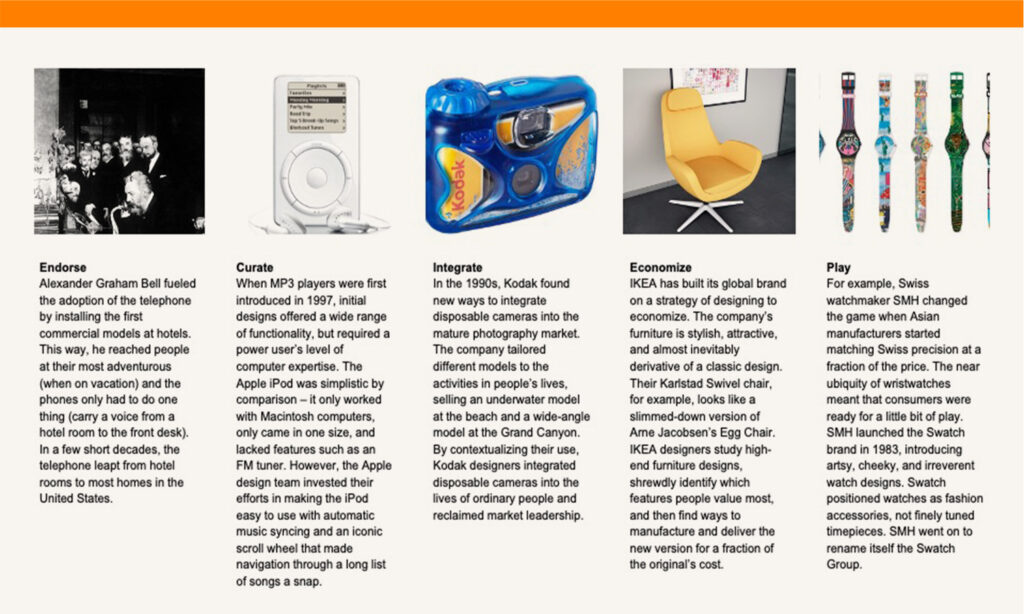Innovation is one thing; success in the marketplace, quite another. By understanding where your product or service falls in the adoption curve, you can focus your design strategy to win with customers and gain traction.
Back in 1999, Honda introduced the Insight, a hybrid-engine car promising greater fuel economy than any automobile ever made. Despite the Insight’s many innovations, the car was a flop, selling just 13,200 units before Honda pulled the plug in 2006. The Insight’s development team incorporated every possible advance in fuel efficiency, but in the process, created a vehicle that was too weird for most mainstream drivers.
Meanwhile, Honda’s arch-rival Toyota was developing its own hybrid car, the Prius. Rather than focus on maximal fuel efficiency, Toyota prioritized the familiar comforts and safety of previous sedans along with significantly improved fuel economy (although not quite as good as the Insight). Toyota kept most things the same, instead highlighting the primary benefit of hybrid engine technology – better gas mileage – with a new dashboard display. The Prius was a runaway success and would go on to sell more than 400,000 units in its first seven years in the United States alone.

Toyota and Honda were in competition to define a new technology, and Toyota won. While technology played a central role in Toyota’s success, other factors were equally important in their victory. One such factor was an effective design strategy. Design strategy is an emerging discipline created to help firms determine what to make and do. Blending design and business strategy, design methods are used to inform business strategy and strategic planning provides a context for design. And, by drawing from adoption theory – the study of how new ideas spread to new audiences – businesses can tailor their offerings to meet the different needs people have at various points in a category’s lifecycle.
Jump Associates has conducted extensive research into design strategies to drive adoption. We’ve developed six generic strategies that play best at different points in a technology’s diffusion. This article will demonstrate how to implement an appropriate design strategy for adoption at a company and explain the theoretical underpinnings of the practice.
From Cornfields to Concept Lab
Adoption theory is a well-established body of research that owes its origins to communications theorist Everett Rogers’s “Diffusion of Innovations.” Rogers charts the rise and fall of ideas, technologies, products, and nations while teasing out the insights, psychographics, and principles needed to apply adoption theory to new fields. Over time, a pattern of diffusion has been shown across numerous disciplines and industries, always with similar conclusions: The adoption of new ideas follows a standard bell curve, and anyone who engages with a given innovation fits into one of five categories.
Here’s what you need to know about each group:
- Innovators are risk takers who have the resources and desire to try new things.
- Early Adopters have a need to be perceived as “in the know” and credible.
- The Early Majority cares more about the benefit they will receive from a new idea or technology than the novelty of the idea alone.
- The Late Majority is openly skeptical of new ideas and tend to have limited economic resources.
- Laggards value tradition and make decisions based on past experiences, which are often limited to isolated social networks.
Design Strategies for Technology Adoption
Download
Choosing the Right Design Strategy to Drive Adoption
New ideas appeal to various groups on the adoption curve at different times for different reasons. Understanding the needs and values of innovators, early adopters, early majority, late majority, and laggards can help determine a set of design strategies that encourage the diffusion of a new product, service, or technology.
- Endorse: Explain the benefits and function of a nascent technology to the world. When first introducing a new technology to the world, companies often need to appeal to innovators and early adopters. Because a new technology may be spotty in its performance, it is critical to design an offering that leverages its strengths and minimizes any potential glitches.
- Curate: Create icons that are selective in their functionality. As a new offering begins to reach early adopters, companies can further adoption by highlighting aspects of the new technology that demonstrate specific benefits and use. Curating is often achieved through iconic designs that are desirable because they emphasize easily understood and valuable functions.
- Integrate: Provide solutions that fit into people’s lives. Unlike early adopters, mainstream users are often unable or unwilling to make the compromises needed to work with a new solution. Companies should therefore look for ways to integrate a technology into people’s habits and routines. An integrating strategy can help a company take a new technology from novel niche to household name.
- Economize: Drastically cut costs of production on already successful technologies. Companies can spur further market penetration by appealing to the late majority with cost-cutting and commoditizing strategies. The secret of designing to economize is not cutting corners arbitrarily but analyzing successful high-end solutions and figuring out which corners to cut to create a true low-cost alternative.
- Play: Find new ways to add value that don’t depend on technical differentiation. To drive adoption of a new technology beyond the mainstream, companies must find ways to appeal to laggards. Often, the inherent familiarity of a widely adopted product can give designers an opportunity to do something different.
- Refresh: Reinvent existing offerings and renew technical differentiation to reach new markets. Once a technology has reached near-universal adoption, it’s incumbent upon existing players and new entrants to reinvent the category. This can mean finding ways to refresh an obsolete technology, often by identifying a novel use for it.

Successful Companies Have a Distinct Vision Within the Adoption Curve
Companies in the same market can succeed by leveraging the same technologies at different points in their diffusion. The three top American computer brands, for example, follow drastically different strategies:
Apple is the quintessential curate company. Its entire business model revolves around wrapping nascent technologies in iconic and easy-to-understand packages.
HP excels at designing to integrate. The company creates ecosystems of offerings that have greater capabilities than any one component. Countless families connect their HP cameras to their HP computer, which connects to an HP printer stocked with HP ink cartridges and HP-branded paper.
Dell Computer succeeds through economizing. Dell has found ways to drive the cost out of established technologies and replicate the look and feel of competitors.
Each of these companies plays to its strengths by following a strategy best suited to its abilities. Apple constantly looks for new technologies that it can curate. HP looks for opportunities to integrate disparate solutions into a seamless whole. And Dell looks for new ways to economize already successful technologies. Each has a distinct vision for the technology industry and pursues it accordingly and has performed best when focusing on doing things its own way.
Originally published in DMI in 2007
Adoption Theory Frames the Best Paths Forward
Companies continually grapple with how to develop effective design strategies that will minimize the inherent risks involved with launching new products, services, and businesses. Understanding diffusion theory helps to frame the introduction of new offerings as an issue of adoption. Rather than give up introducing new technologies to the market or relying on random luck for success in such endeavors, design managers can craft strategies that play to their strengths, minimize risk, drive adoption, and ultimately fulfill their companies’ larger growth objectives.

 Dev Patnaik
Dev Patnaik


